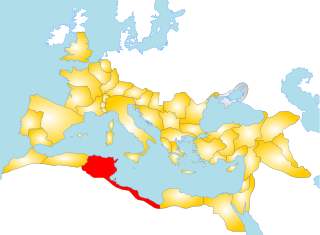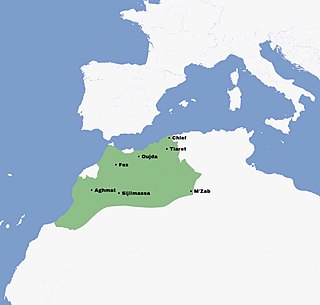
Much of the history of Algeria has taken place on the fertile coastal plain of North Africa, which is often called the Maghreb. North Africa served as a transit region for people moving towards Europe or the Middle East, thus, the region's inhabitants have been influenced by populations from other areas, including the Carthaginians, Romans, and Vandals. The region was conquered by the Muslims in the early 8th century AD, but broke off from the Umayyad Caliphate after the Berber Revolt of 740. During the Ottoman period, Algeria became an important state in the Mediterranean sea which led to many naval conflicts. The last significant events in the country's recent history have been the Algerian War and Algerian Civil War.

Ibn Khaldun was an Arab sociologist, philosopher, and historian widely acknowledged to be one of the greatest social scientists of the Middle Ages, and considered by many to be the father of historiography, sociology, economics, and demography studies.

Medieval Muslim Algeria was a period of Muslim dominance in Algeria during the Middle Ages, spanning the millennium from the 7th century to the 17th century. The new faith, in its various forms, would penetrate nearly all segments of society, bringing with it armies, learned men, and fervent mystics; in large part, it would replace tribal practices and loyalties with new social norms and political idioms.

Tlemcen is the second-largest city in northwestern Algeria after Oran and is the capital of Tlemcen Province. The city has developed leather, carpet, and textile industries, which it exports through the port of Rachgoun. It had a population of 140,158, as of the 2008 census.

Ifriqiya, also known as al-Maghrib al-Adna, was a medieval historical region comprising today's Tunisia and eastern Algeria, and Tripolitania. It included all of what had previously been the Byzantine province of Africa Proconsularis and extended beyond it, but did not include the Mauretanias.

The Barghawatas were a Berber tribal confederation on the Atlantic coast of Morocco, belonging to the Masmuda confederacy. After allying with the Sufri Kharijite rebellion in Morocco against the Umayyad Caliphate, they established an independent state in the area of Tamesna on the Atlantic coast between Safi and Salé under the leadership of Tarif al-Matghari.

The Banu Hilal was a confederation of Arab tribes from the Najd region of the central Arabian Peninsula that emigrated to the Maghreb region of North Africa in the 11th century. Masters of the vast plateaux of the Najd, they enjoyed a somewhat infamous reputation, possibly owing to their relatively late conversion to Islam and accounts of their campaigns in the borderlands between Iraq and Syria. When the Fatimid Caliphate became the rulers of Egypt and the founders of Cairo in 969, they hastened to confine the unruly Bedouin in the south before sending them to Central North Africa and then to Morocco.
The Zenata are a group of Berber tribes, historically one of the largest Berber confederations along with the Sanhaja and Masmuda. Their lifestyle was either nomadic or semi-nomadic.

Abu Zakariya Yahya (Arabic: أبو زكريا يحيى بن حفص, Abu Zakariya Yahya I ben Abd al-Wahid was the founder and first sultan of the Hafsid dynasty in Ifriqiya. He was the grandson of Sheikh Abu al-Hafs, the leader of the Hintata and second in command of the Almohads after Abd al-Mu'min.

The Maghrawa or Meghrawa were a large Zenata Berber tribal confederation whose cradle and seat of power was the territory located on the Chlef in the north-western part of today's Algeria, bounded by the Ouarsenis to the south, the Mediterranean Sea to the north and Tlemcen to the west. They ruled these areas on behalf of the Umayyad Caliphate of Cordoba at the end of the 10th century and during the first half of the 11th century.
The Sufris were Khariji Muslims in the seventh and eighth centuries. They established the Midrarid state at Sijilmassa, now in Morocco.
The Berber Revolt or the Kharijite Revolt of 740–743 AD took place during the reign of the Umayyad Caliph Hisham ibn Abd al-Malik and marked the first successful secession from the Arab caliphate. Fired up by Kharijite puritan preachers, the Berber revolt against their Umayyad Arab rulers began in Tangiers in 740, and was led initially by Maysara al-Matghari. The revolt soon spread through the rest of the Maghreb and across the straits to al-Andalus.

The BanuMa'qil is an Arab nomadic tribe that originated in South Arabia. The tribe emigrated to the Maghreb region of North Africa with the Banu Hilal and Banu Sulaym tribes in the 11th century. They mainly settled in and around the Saharan wolds and oases of Morocco; in Tafilalt, Wad Nun, Draa and Taourirt. With the Ma'qil being a Bedouin tribe that originated in the Arabian Peninsula, like Banu Hilal and Banu Sulaym, they adapted perfectly to the climatic desert conditions of the Maghreb, discovering the same way of life as in the Arabian Peninsula. The Ma'qil branch of Beni Hassan which came to dominate all of Mauritania, Western Sahara, south Morocco, and south-west Algeria, spread the Hassaniya Arabic dialect, which is very close to classical Arabic.
The Banu Ifran or Ifranids, were a Zenata Berber tribe prominent in the history of pre-Islamic and early Islamic North Africa. In the 8th century, they established a kingdom in the central Maghreb, with Tlemcen as its capital.

The medieval era of Tunisia began with what would eventually return Ifriqiya to local Berber rule. The Shia Islamic Fatimid Caliphate departed to their newly conquered territories in Egypt leaving the Zirid dynasty to govern in their stead. The Zirids would eventually break all ties to the Fatimids and formally embrace Sunni Islamic doctrines.
The Ifranid Emirate of Tlemcen or Ifranid Kingdom of Tlemcen, was a Kharijite state, founded by Berbers of the Banu Ifran in the eighth century, with its capital at Tlemcen in modern Algeria.

The Sulaymanid dynasty was an Arab Muslim dynasty in present-day western Algeria, ruling from 814 to 922. The dynasty is named after the founder, Sulyaman I, who was the brother of Idris I, the founder of the Idrisid dynasty based in Fez. Both Sulayman and Idris, as great grandchildren of Hasan ibn Ali, were sharifs descended from Muhammad.
The Hammadid expedition to Tlemcen was a military operation undertaken by the Hammadids against the Ifrenids with the aim of dismantling their influence in the Maghreb.
Abu Kamal Tamim bin Ziri bin Ya'la Al-Yafrani, was the leader of the Berber Zenata tribe known as Banu Ifren from 1029 to 1035 during the Middle Ages in the Maghreb. He is the grandson of Yala Ibn Mohammed.
The Talkata or Telkata constitute a branch of the sedentary faction of the Sanhaja in central Maghreb, with their stronghold being Titteri, during the Middle Ages. They played a prominent role in the history of the Muslim Maghreb and are the progenitors of the Zirid dynasties that ruled over central Maghreb, Ifriqiya, and Al-Andalus.











